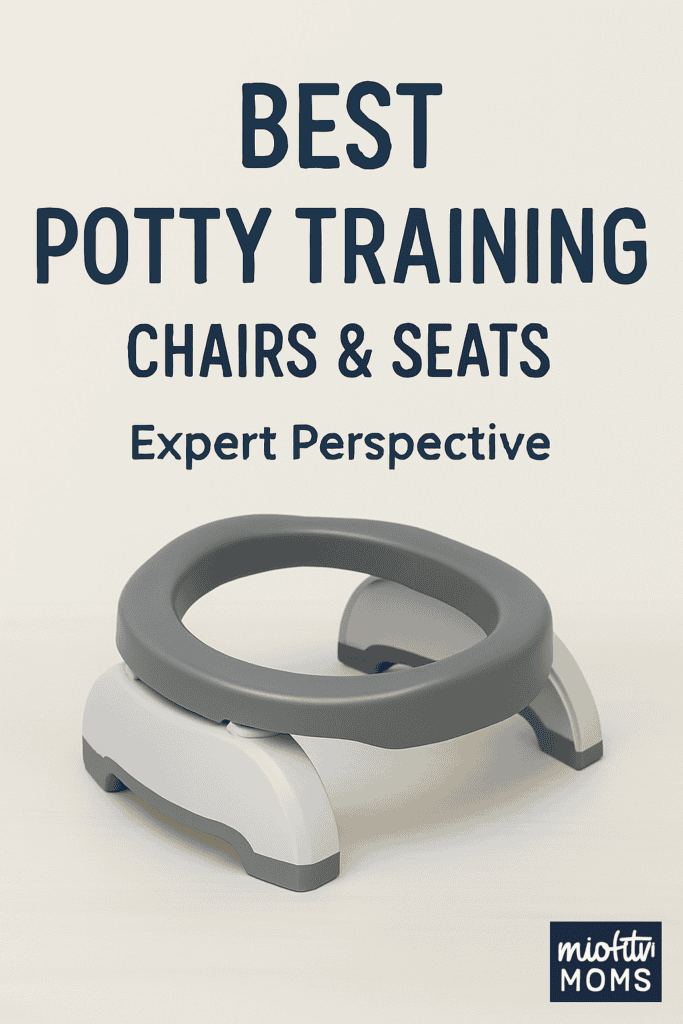In This Article...

What really matters when choosing your toddler’s first potty.
There are a thousand options out there — musical potties, cartoon-themed thrones, mini toilets that “flush.” But let’s take a breath.
The best potty for a toddler is the one that makes them feel in control.
Look for:
- A low, stable base they can sit on and get up from easily
- No bells, whistles, or distractions (playtime and potty time are separate)
- A removable bowl that’s easy to clean
- Optional: A backrest or splash guard (especially for boys!)
What’s not necessary? Noise, lights, or a “big kid” look. The potty should feel safe and simple, not like a prize to earn.
One great example that checks these boxes? The BabyBjörn Smart Potty. It’s low, sturdy, distraction-free, and easy to clean — perfect for toddlers just starting out.”

Best Potty for Boys
It’s less about standing up — and more about starting small.
Let’s bust a myth: Boys don’t need to stand to learn.
The best potty for boys is one that lets them sit comfortably and focus on what their body is doing. Pee and poop learning go together, and standing too early can interrupt that.
Once they’re confidently using the potty, you can introduce standing later, with fun tools like:
- Floating targets
- “Pee races” into the bowl
- Dad modeling the process (while sitting down at first!)
But to begin? Low to the ground. Comfortable. With zero pressure.
Best Potty for Baby
If you’re starting early, keep it small, soft, and pressure-free.
Some families explore potty learning in babyhood (6–18 months). That’s amazing — This is exposure, not expectation.
For early learners, the best baby potty is:
- Simple: no buttons, no noise
- Compact: fits tiny legs and bottoms
- Portable: easy to move from room to room
- Safe: sturdy with non-slip feet
And most of all: Used in moments of connection, not performance. Let them sit while reading a story, blowing bubbles, or just after waking — and celebrate the try, not just the “success.”
Best Training Toilet
Skip the fancy. Go for what works for your real life.
When people say “training toilet,” they usually mean something that looks like a miniature adult toilet. While cute, It’s not about realism — it’s about reliability.
Training toilets should be:
- Predictable: always in the same place
- Easy to clean: avoid anything with lots of crevices or cushions
- Approachable: not too cold, high, or loud
Some parents prefer potty seats that fit over real toilets (especially for travel or tighter spaces). If you go that route, make sure to add:
- A step stool with handles
- A seat reducer that doesn’t shift or wiggle
- A place for their feet to rest (this is so important for pooping)
Remember, comfort leads to confidence.
Best Potty Training Set
Buy only what you’ll actually use — and skip the rest.
It’s easy to go overboard with bundles that promise to “make potty training fun!” This isn’t a party. It’s a process.
A great potty training set includes:
- 1 floor potty (or potty seat with stool)
- 1–2 waterproof mattress covers
- A few pairs of easy-up underwear
- A wet bag or portable potty for outings
- Maybe a potty-time storybook or calm playlist
What to skip?
- Sticker charts
- “Flushable” wipes (they often aren’t)
- Potty watch timers (use routines, not alarms)
Potty learning happens through rhythm, not gadgets.
Best Toilet for Potty Training
When your little one’s ready for the “real thing” — keep it steady and small.
If your child prefers the big toilet (or you want to go that route from the start), that’s great just make sure it’s safe and grounded.
Essentials:
- A non-slip step stool — height is key
- A seat reducer that won’t shift
- A footrest — this is non-negotiable for poop success
And just like with a floor potty, don’t rush them off. Let them sit, breathe, and relax. You’re not training for efficiency — you’re creating a new habit.
FAQ: Potty Shopping Questions, Answered
Q: What’s better — a floor potty or a toilet seat?
A: Both can work. Choose a floor potty for comfort and independence. Use a toilet seat if you need to save space or mimic adult routines. Just always provide a footrest.
Q: Do I need a different potty for boys and girls?
A: Not at first. Kids of all genders should sit to start. Later, you can add a splash guard or introduce standing for boys.
Q: What’s the best portable potty?
A: Look for foldable or bucket-style potties that seal in mess and are easy to clean. The Potette Plus or any seat with disposable liners for road trips.
Q: Are potty chairs with sounds or lights helpful?
A: Usually not. They distract from body awareness and can create dependency. Keep the process quiet, calm, and focused on sensation.